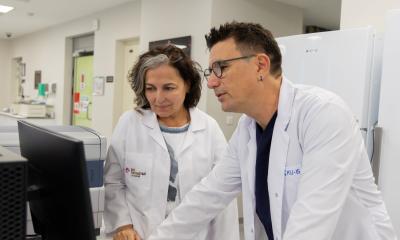Recurrent aphthous stomatitis
Research comes to terms with old ideas about canker sores
A burning pain sensation – and treatments that do not work. This is what daily life is like for many of those who suffer from recurrent aphthous stomatitis. Research from the Sahlgrenska Academy now sheds new light on the reasons behind this condition found in the mouth.

“There are many misconceptions regarding the reasons for the ulcers and the care of this patient category is hugely neglected despite the fact that many suffer a great deal from their symptoms. Patients may experience a general feeling of illness, and they have difficulties in eating and speaking and may not be able to go to school or work for several days due to the lesions,” says Maria Bankvall, dentist and postdoctoral researcher in Odontology.
Mouth blisters, cold sores or apthae are words that are normally used to describe this specific type of lesion, which in medical terms is called recurrent aphthous stomatitis (RAS). The condition is considered one of the most common lesions of the oral mucosa found in the world today.
The lesions have a typical appearance with a red halo surrounding a whitish area, and they can appear anywhere in the non-keratinized mucosa, i.e., on the inside of the cheeks and lips, at the floor of the mouth, on the sides of the tongue and in the throat.
Lots of different causes
The lesions smart and burn and can be greatly disabling for anyone affected. Today there is no cure, instead treatment strategies are aimed at relieving the symptoms using none prescription and/or prescription drugs. “For a long time, it was believed that this condition was due to a virus, in the same way as mouth herpes, and many physicians and dentists treat aphthous stomatitis and herpes in the same way, also because it can be difficult to clinically distinguish the two conditions. The patient is often given anti-viral medication, which is a suitable treatment for herpes, but does not relieve aphthous stomatitis,” says Maria Bankvall.
“RAS should probably not be regarded as a specific disease but as a general symptom of the body due to an imbalance similar to a headache or a fever,” says Maria Bankvall. Her research points to the fact that there is great complexity and multiple interacting factors.
Hereditary is an important factor as well as the bacterial flora in the mouth, our immune system and environmental factors. The thesis presents a theoretic frame for causality based on existing research and their own patient studies.
Genes and bacterial flora
A number of different genes have been identified as being of importance. The research also shows that the bacterial flora in the healthy oral mucosa seems to differ in people with RAS compared to healthy control subjects.
A certain sub-group of patients may also suffer from a food allergy, but we do not know that much about tolerance mechanisms in the mouth. The importance of the immune system in the oral cavity has also been studied in the thesis, initially with experiments on mice. “Today there is a great deal of knowledge regarding the two major conditions in the oral cavity, i.e., caries and periodontitis. However, there are still large information gaps when it comes to different types of oral mucosal lesions. Hopefully, our conclusions can contribute to increasing the knowledge regarding the most common lesions that affect this part of the mouth,” says Maria Bankvall.
Source: University of Gothenburg
11.04.2017










